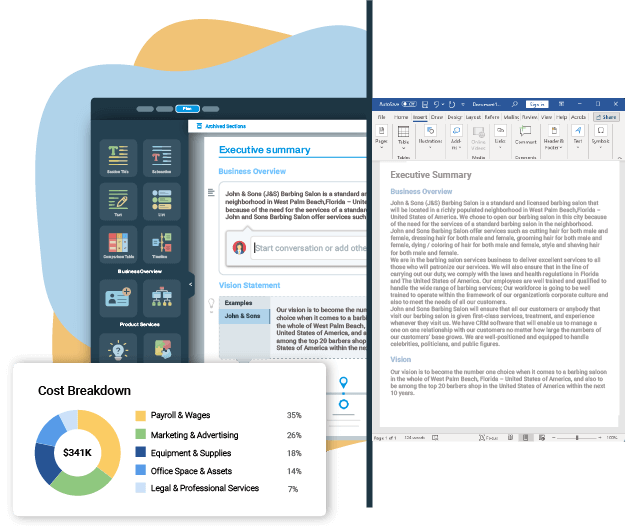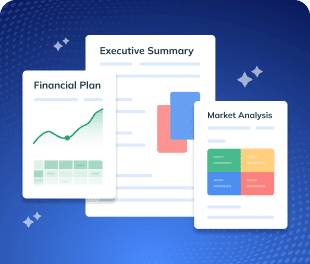
Are you thinking of starting a truck owner operator business? We have prepared a solid truck owner operator business plan sample that guides you on every stage of your business plan writing.
Download Template
The American economy depends heavily on the trucking sector, which is in charge of moving commodities and goods around the nation. Truck owner-operators play a crucial part in this sector, offering both businesses and consumers a useful service.
Thus, are you planning to be a truck operator? If yes, then you need to plan your whole business out.
Need help writing a business plan for your truck owner operator business? You’re at the right place. Our truck owner operator business plan template will help you get started.

Free Business Plan Template
Download our free truck owner operator business plan template now and pave the way to success. Let’s turn your vision into an actionable strategy!
Writing a truck owner operator business plan is a crucial step toward the success of your business. Here are the key steps to consider when writing a business plan:
An executive summary is the first section planned to offer an overview of the entire business plan. However, it is written after the entire business plan is ready and summarizes each section of your plan.
Here are a few key components to include in your executive summary:
Ensure your executive summary is clear, concise, easy to understand, and jargon-free.
Say goodbye to boring templates
Build your business plan faster and easier with AI
Plans starting from $7/month

The business overview section of your business plan offers detailed information about your company. The details you add will depend on how important they are to your business. Yet, business name, location, business history, and future goals are some of the foundational elements you must consider adding to this section:
This section should provide a thorough understanding of your business, its history, and its future plans. Keep this section engaging, precise, and to the point.
Read More: How to Write a Company Overview for a Business PlanThe market analysis section of your business plan should offer a thorough understanding of the industry with the target market, competitors, and growth opportunities. You should include the following components in this section.
Here are a few tips for writing the market analysis section of your owner operator trucking business plan:
The product and services section should describe the specific services and products that will be offered to customers. To write this section should include the following:
In short, this section of your truck owner operator plan must be informative, precise, and client-focused. By providing a clear and compelling description of your offerings, you can help potential investors and readers understand the value of your business.
Writing the sales and marketing strategies section means a list of strategies you will use to attract and retain your clients. Here are some key elements to include in your sales & marketing plan:
Overall, this section of your truck owner operator business plan should focus on customer acquisition and retention.
Have a specific, realistic, and data-driven approach while planning sales and marketing strategies for your business, and be prepared to adapt or make strategic changes in your strategies based on feedback and results.
The operations plan section of your business plan should outline the processes and procedures involved in your business operations, such as staffing requirements and operational processes. Here are a few components to add to your operations plan:
Adding these components to your operations plan will help you lay out your business operations, which will eventually help you manage your business effectively.
The management team section of business plan provides an overview of your business’s management team. This section should provide a detailed description of each manager’s experience and qualifications, as well as their responsibilities and roles.
This section should describe the key personnel for your truck owner operator services, highlighting how you have the perfect team to succeed.
Your financial plan section should provide a summary of your business’s financial projections for the first few years. Here are some key elements to include in your financial plan:
Be realistic with your financial projections, and make sure you offer relevant information and evidence to support your estimates.
To create automatic financials for your own business plan, we recommend Upmetrics. Create your own business plan.
The appendix section of your plan should include any additional information supporting your business plan’s main content, such as market research, legal documentation, financial statements, and other relevant information.
Use clear headings and labels for each section of the appendix so that readers can easily find the necessary information.
Remember, the appendix section of your business plan should only include relevant and important information supporting your plan’s main content.
The Quickest Way to turn a Business Idea into a Business Plan
Fill-in-the-blanks and automatic financials make it easy.
This sample truck owner operator business plan will provide an idea for writing a successful truck owner operator plan, including all the essential components of your business.
After this, if you still need clarification about writing an investment-ready business plan to impress your audience, download our truck owner operator business plan pdf.
Food Truck Business Plan
Tow Truck Business Plan
Business Plan Cover Page Design Guide
Simple Business Plan Table of Contents
Who Should be Involved in Preparing the Business Plan?
Guide on How to Format a Business Plan
A business plan is an essential tool for anyone looking to start or run a successful truck owner operator business. It helps to get clarity in your business, secures funding, and identifies potential challenges while starting and growing your business.
Overall, a well-written plan can help you make informed decisions, which can contribute to the long-term success of your truck owner operator company.
There are several ways to get funding for your truck owner operator business, but self-funding is one of the most efficient and speedy funding options. Other options for funding are:
Apart from all these options, there are small business grants available, check for the same in your location and you can apply for it.
There are many business plan writers available, but no one knows your business and ideas better than you, so we recommend you write your truck owner operator business plan and outline your vision as you have in your mind.
A lot of research is necessary for writing a business plan, but you can write your plan most efficiently with the help of any truck owner operator business plan example and edit it as per your need. You can also quickly finish your plan in just a few hours or less with the help of our business plan software.
About the Author
Upmetrics is the #1 business planning software that helps entrepreneurs and business owners create investment-ready business plans using AI. We regularly share business planning insights on our blog. Check out the Upmetrics blog for such interesting reads. Read more

Turn your business idea into a solid business plan